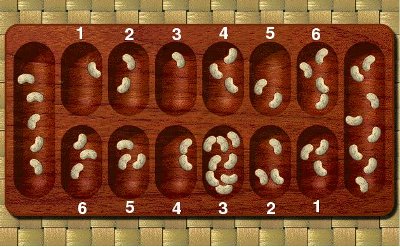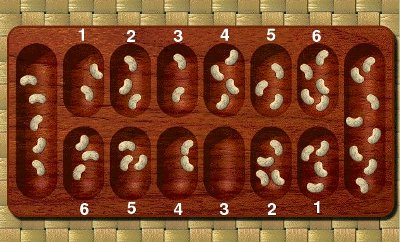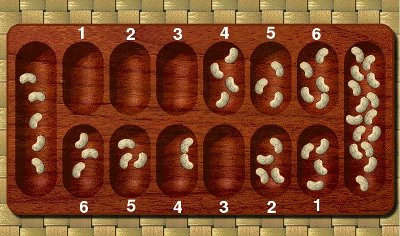
by John P. Pratt
Mon 14 Sep 2009
Basic rules for all variations.
 |
1. The game usually begins with four seeds in each pit. More can cause the game to drag on too long.
2. When the seeds are sown, the capture pit is not included. Figure 1 shows the board before the Lower Player plays his Pit 3. Figure 2 shows the board after that move. Pit 3 had 8 seeds, and they were placed in Pits 2 and 1 of the Lower Player, and all of the pits of the Upper Player. The capture pit was not included in the sowing. If there are enough seeds in a pit to go all the way around the board, then no seed is dropped in the original pit that is being played. In other words, the pit being played always remains empty after a move.
 |
4. When a capture is made, captures are simultaneously made in all opponent pits in a row counting back from the final pit, which also contain two or three stones after the move. To be captured, the pits must all contain that number with no exceptions.
For example, in the example being considered, the final seed was sown into the Upper Player's Pit 1. After the move, it had 2 or 3 seeds (2 to be exact), so it is captured. But Pit 2, and Pit 3 also have 2 or 3 seeds after the move, and they are all in a row, next to Pit 1, so they are also captured. Pit 5 also ends up with 3 seeds, but it is not consecutive with the others, that is, Pit 4 with 4 seeds is in between, so Pit 5 is not captured. Figure 3 shows the result after the captured seeds are placed in the Lower Player's capture pit.
 |
The opponent can be left with no seeds to play by capturing all of his last seeds with the move. In other words, a player is not required to pass his opponent seeds if he can capture all of the opponent's seeds with his move. In that case, the player with seeds remaining, captures all of his own seeds also.
There is a penalty for failing to pass your opponent seeds if possible when the opponent will have none to play with on his next move. If it was possible to pass him some, and a different move was made so that he still has none, then the opponent with no seeds captures all of the remaining seeds of the player who failed to pass him some.
6. If at the end of the game the situation arises that the players are simply passing the stones to each other in an endless loop, then the players can agree to end the game. In that case, the seeds still on the board are not counted by either player.